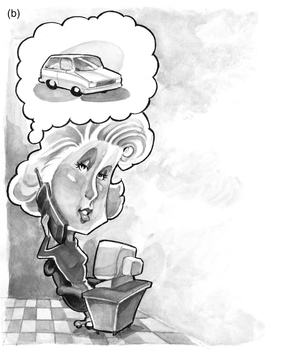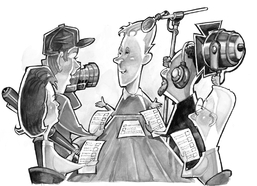25
Communication: The Foundation of Production
Randal K. West


Figure 25-1
I once directed an infomercial to sell jewelry during the holiday season. The script writer thought it would be cute to have a scene with our model and a baby reindeer. The logistics and cost of a deer were substantial, so I requested that the writer turn the deer into a rabbit. Three days before the shoot the prop manager left a message for me asking what color rabbit I wanted. I emailed back and said, “Something with mixed colors would be cute.” The property manager said she couldn’t find a mixed-color rabbit. She did say that she could have one custom painted, but that was going to bang my budget pretty hard. At this point, I decided I needed to pick up the phone and actually speak with her. It was then that I discovered that she was trying to get a Volkswagen Rabbit.
The most important thing a director has to do is communicate. The director must find ways to consistently communicate to everyone who participates in the project, including the producer, client, the designers, crew and talent. I had a director tell me a concept for a solid and original project, but when the project was completed, the concept was just not there. Asking around revealed that the crew and the talent never understood the concept and so the director’s vision never found its way into the end-product.
Concept Proposal
As soon as you have an understanding of the scope and complexity of a project, you should write up a concept proposal. A concept proposal details the components of the project in plain English. It should include:
Title —the title is important, but it only has to be a preliminary title and often changes later.

Figure 25-2 Will you record me? A concept proposal details the component on the project in plain language.
Objective —the project objective states the goals for the project. Even if the project is as simple as shooting a high school reunion, explicitly stating the objectives might reveal that you will need to not only shoot footage of the reunion, but that you will need to interview the participants and collect archive materials (like a yearbook) as well.
Summary —this should be a description of the proposed show elements and how they are to function. For example, “Documentary style with B-roll” or “Talking heads with host and expert.”
Talent requirements —a short list of the required talent, including age, gender and a brief description of each person, as well as what they are required to do. Do you need talent that can act? Will there be any speaking roles? Will you need any extras to be in the background?
Proposed length —you will need to know a precise total running time up front, even if the timeline is not set in stone. You will also eventually need a detailed timeline, but for now, a simple schedule that details major events such as when the script needs to be ready, proposed shooting dates, posting dates and when the video will be delivered.
Design elements —this section will detail the artistic feel of the project. For example: “We will shoot this in a loose-camera documentary style which will feel and seem very real. The director will be invisible and the talent will not answer questions or talk to the camera.” This important section lets you communicate your vision and immediate stylistic desires.
Resources required —this is where you state your vision for the scope of shooting. For example, explicitly state that your project is to be shot entirely in “Practical homes” (actual locations) or if it will require a studio set. The more detailed you are in this section, the better off you’ll be later. Include the proposed crew, equipment requirements, whether needed items are available or need to be purchased or rented, locations and any travel needs.
Proposed budget —now you should be ready to estimate a simple budget. Break your budget down into pre-production, production and post-production, talent and travel line items.
The Production Meeting
The next step is to call a production meeting with all the major players: the director of photography, sound engineer, camera operator, prop manager, art director and anyone else who will be making creative decisions during the project. The production meeting gives you a chance to communicate your concept proposal to your team.
The Outline
If the project doesn’t involve actual written dialogue, then an outline may be all that you need. A project outline breaks the production into isolated segments and defines exactly what to shoot within the segment, including examples of some of the desired content, approximate times for each segment, and the segment objective.
If the project is a high school reunion, the outline might include a segment where the partygoers are seen arriving at the reunion and greeting each other for

Figure 25-3 Syncing up—the production meeting gives you a chance to communicate your concept proposal to your team.
the first time in a long while. The outline would specify approximately how long the camera crew should stay at that location and how long the edited and finished segment should run. The outline would also detail whether the shots are to be B-roll, video-only footage for a musical montage or if they require audio as well. If you only need audio as a reference or if background music (or narration) will cover it, then the microphone on the camera might work just fine. You can note this as “wild” sound or ambient sound in your outline. If you need high-quality sound, specify that as well, so your camera operator can prepare properly.
The Script
A script is often the best choice for a project that involves written dialogue. A standard television script is formatted with a column on one side of the page that describes the visuals and a column on the other side of the page that designates who is talking and then states the dialogue. One side should contain the description of the shot: “Hostess walks out the front door of the house and walks into a one-shot as she addresses the camera”, or a

Figure 25-4 The script—a script is often the best choice for a project that involves written dialogue.
thumbnail sketch. The other side indicates what she says.
Shooting Schedule
Finally, you need to break the project into a strict shooting schedule, indicating the order in which you intend to shoot the project. Since the actual shoot will involve the most coordination and the most people, a well-planned shooting schedule is critical.
If the entire project takes place in the same environment, you may choose to shoot it chronologically, but usually you shoot by location. This will require shooting scenes out of order, so you need to communicate to your actors what you will be shooting and when.
Too Much? Too Soon?
If all this communicating seems more complicated than it is worth, just take it a few steps at a time. I know a director who publishes notes after every meeting or phone conversation, summarizing the “action steps” from each meeting. You need to find your own comfort level regarding how much written and verbal communication works for you.
Communication is the single most important element a director brings to a project. If you have a brilliant idea, but cannot successfully communicate your vision, you may end up with a custom-painted compact car instead of a furry little friend at your shoot.
